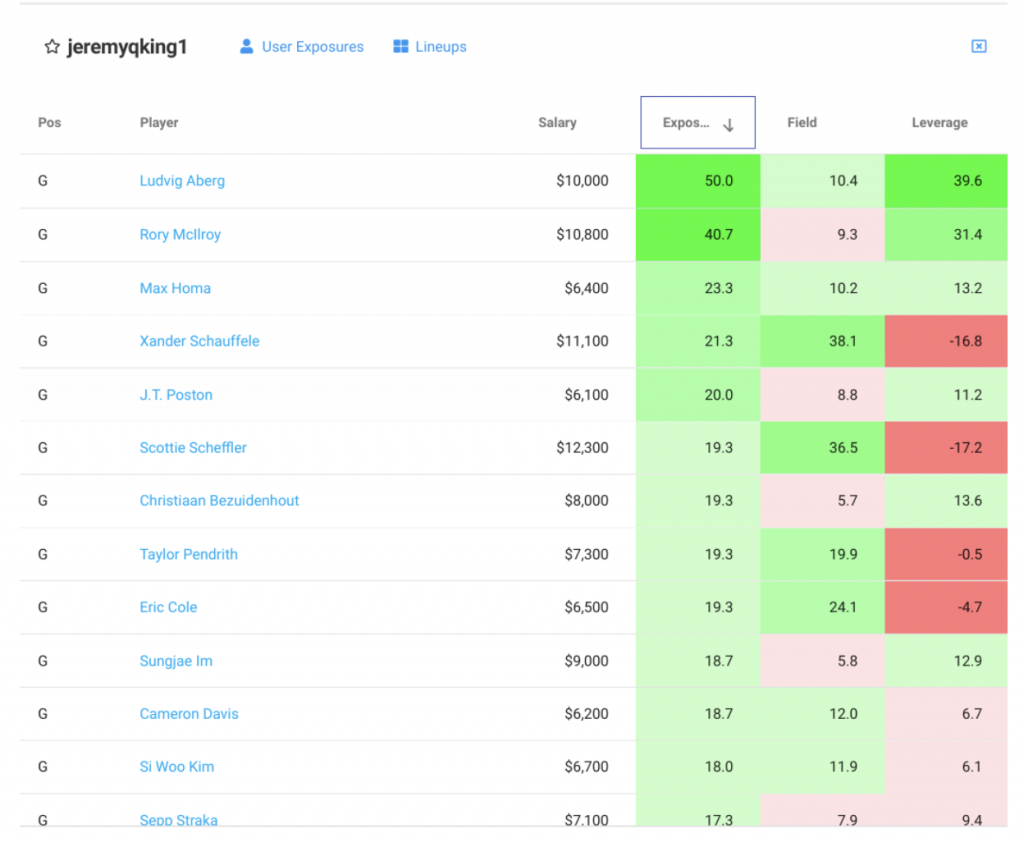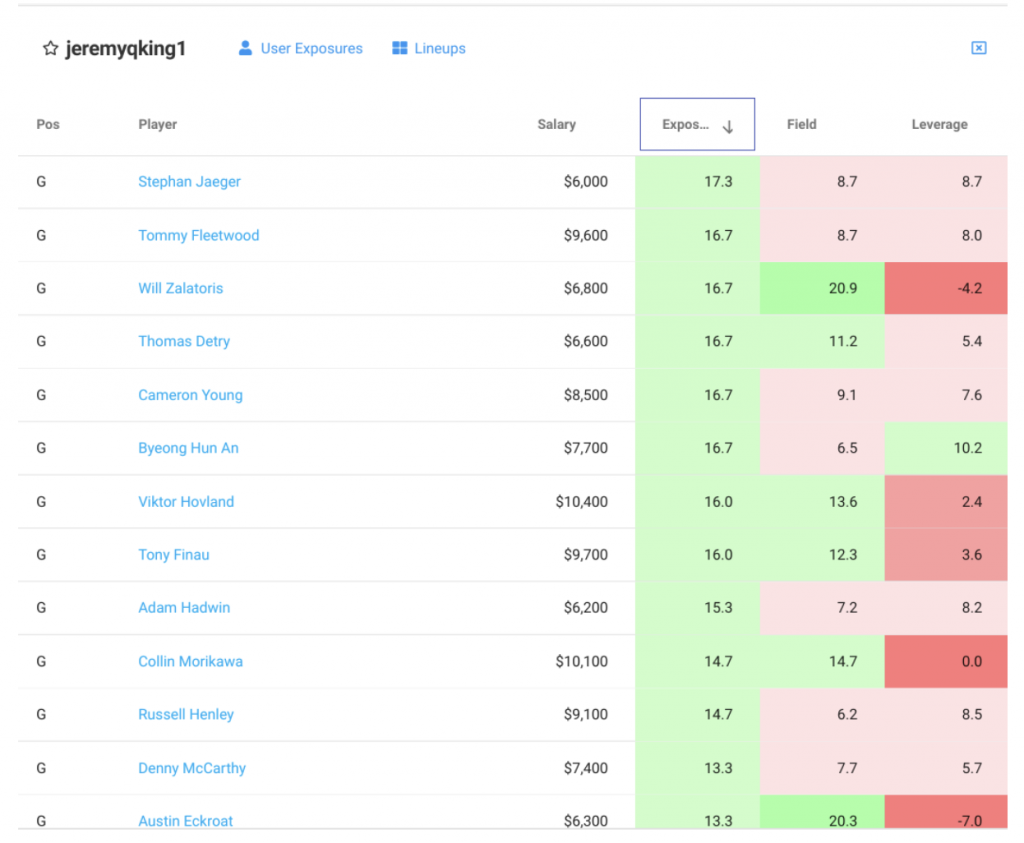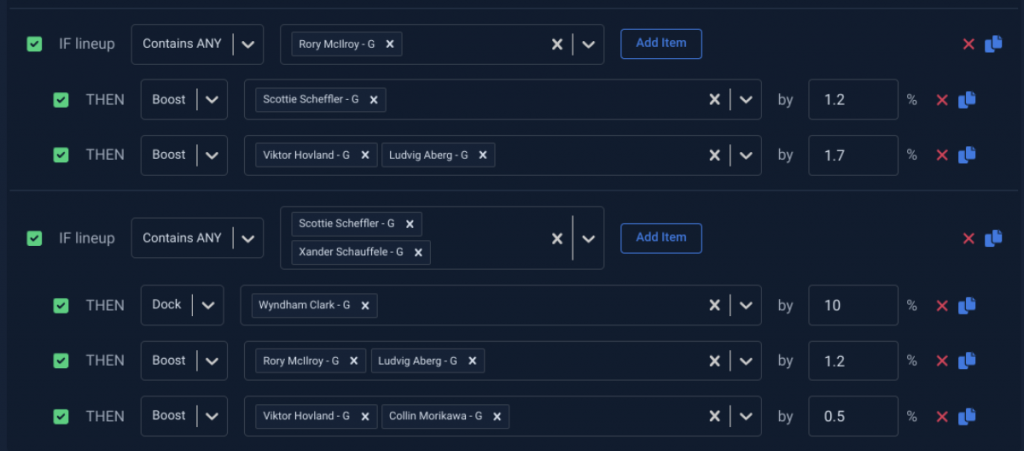Just as our Adam Levitan does each week during the NFL season, every Monday we’ll be using the week-long nature of DFS golf to take advantage of the extended feedback loop by analyzing what went right and what went wrong in the previous week’s slate, regardless of results.
Each week, we’ll review a variety of cash-game & GPP lineups in an effort to take you inside our thought process as we approached Thursday’s lock and how our projection- and ownership-based expectations stacked up against the field.
I did not think that I would be writing another one of these, especially so soon, but you readers now have to endure ANOTHER article from me. Once again, the reward for cashing a six-figure score is to write the GPP Lineup Review and give fellow contributor Sky a break on the week! Ridiculous stuff here. All jokes aside, Sky is planning on a different article that dives into the Tour Championship because of the uniqueness of a staggered, 30-man field. Anyways, as I did for the 3M Open a couple of weeks back, I’ll be reviewing both my second-place lineup in the Sand Trap that took down $100K as well as the thought process that went into my MME set in general. For anyone that does MME, it is really important to steer clear of looking at sole lineups (unless you feel like you made some mistakes) and just review your set overall and how you got there. I’ll be trying to do just that for you here.
DraftKings Large-Field Tournament

I’ll start by talking about this lineup in particular and then move on to my thoughts about my overall MME set in the sections after. This week’s Sand Trap was consistent with past contests, with an $800K total prize pool, 37K total entries, and 25% to first. For those of you that have been following my articles for a while, you know I am all about roster construction giving you an edge in DFS golf. For those of you reading this article (probably for free) and are new to my writing — I am a big believer that PGA DFS is a game of roster construction first and foremost. This is because PGA projections are so volatile on a week in, week out basis. Golf is one of the only sports where a true scrub can be the highest-scoring player on the slate some weeks. Can you imagine if someone like Davis Bertans (shout-out to you NBA grinders) scored 80 DFS points and beat out Nikola Jokic, Lebron James, and Kevin Durant? No, you really can’t. That happens in PGA DFS.
As you can see from the above, my lineup started with a Xander-Aberg stack up top. Aberg, who happened to be my flag plant this week (screw Adam Levitan’s rules!), was talked about heavily in my Large-Field GPP Breakdown ahead of the event. I mentioned in the article that stars-and-scrubs builds that featured one of Rory or Aberg was probably the best way to play those instead of the more expensive and more heavily owned Scottie-Xander builds that much of the field leaned into. Low and behold, here were the exposures of those stars-and-scrubs stacks:
- Scottie Scheffler + Xander Schauffele – 5.4%
- Scottie Scheffler + Rory Mcilroy – 1.37%
- Scottie Scheffler + Ludvig Aberg – 1.62%
- Xander Schauffele + Rory McIlroy – 1.78%
- Xander Schauffele + Ludvig Aberg – 2.09%
Now, you might not think that these differences in percentages mean that much, but they really do given the top-heavy prizes in large-field GPPs and the amount of entries in the field. Think about it: Each percentage point difference in a 37,000-entry field is an additional 370 entries you have to beat. That’s a lot of lineups! Taking these small edges where appropriate is one of the concepts I really try to hammer in large-field golf GPPs and have had success with.
The rest of my lineup featured four players that I was overweight the field on, but not by a significant amount. As with most golf weeks, I tend to lean into more variability as you go down in price, knowing the skill level decrease tends to ramp up the volatility. You’ll see in my MME review later in this article some of the things that I’ve been doing in The SOLVER to ensure that I’m creating unique combinations where projections are oftentimes quite similar.
Now, let’s take a look at my MME set exposures in the Sand Trap:


The first thing that I’d like to point out is that I decided to FULL FADE Max Greyserman, Eric Cole, and Nick Dunlap this week. I was also underweight Will Zalatoris. While the ETR Discord knows that I am all about lineups over players, this illustrates a bit how player weights will of course inevitably impact how my lineups are built in the optimizer. Being underweight four of the chalkiest players on the week in the $6Ks forced me into being overweight Thomas Detry, Max Homa, J.T. Poston, Cameron Davis, and Si Woo Kim, all of whom had pretty solid weeks at their price points. The interesting thing about this is that this particular lineup could have landed on Cam Davis and Si Woo Kim, for example, and totally blown away the whole field. There was obviously no way for me to know that beforehand, but I think this illustrates how the different levers that you pull can really impact how you set yourself up for success in the long run. Taking these leverage spots consistently and setting yourself up to take advantage of them can result in some major wins.
Understanding Ownership and Taking Advantage
One of the most, if not THE most important part about DFS is player ownership. Last week’s Large-Field GPP Breakdown talked a LOT about Scheffler and Xander (specifically Scheffler) and the possible steam that they would take going into the contest. Before contest lock, I was banging the drum that Scheffler ownership would likely reach the mid 30s, which it did. What I didn’t really expect was Xander’s ownership also reaching that high. I was able to correctly identify that the field was going to lean heavily into these two players, often playing them together. In DFS, with every action there is going to be some type of impact on other players. Ownership always has to sum up to 600% overall (six spots in a lineup x 100%). Therefore, with my hunch that Scottie and Xander ownership might come in higher than expected, I figured that would directly impact Rory and Aberg ownership. This turned out to be true and led me to my Aberg flag plant. As you know, I am always going to flag-plant the player I believe provides the best leverage on the slate — Aberg was that player because of my thoughts in this paragraph. I then used this concept to take it a step further: If people were going to gravitate towards Scheffler/Xander together in stars-and-scrubs lineups, I can use Aberg and Rory in stars-and-scrubs lineups with one of those two to effectively optimize lineups with either Scheffler/X. We can see this play out in the duo ownerships I listed above.
Because I am such a nice guy, unlike Discord bad guy joegogh, I’ll give you a little bit of a look under the hood in The SOLVER.

What I am trying to accomplish in the above screenshot is the following:
- Increase the amount of Scottie or Xander + Rory or Aberg lineups I have
- Decrease the amount of Scottie or Xander + chalky Wyndham Clark
- Increase the amount of Rory + Aberg or Rory + Hovland I have
I also employed the following MAX rule:

The reasoning here is that without Greyserman, Cole, and Dunlap in my pool, I really only needed to guard against playing Davis Thompson, who projected to be almost 20% owned, with Scottie Scheffler, who I expected to steam. I employed a few other MAX rules similar to this one, but I will just use the above as an example as I’m not THAT nice.
Finalizing an MME Set
I talked about this in my GPP Lineup Review a couple of weeks back, but I almost never just take what The SOLVER spits out and immediately upload it. I am probably pressing that optimize button over 300 times throughout my process, constantly massaging player ownerships and combination ownerships to my liking. I will also go through and sort and X lineups based on a variety of different roster construction things that I am liking on the week. I typically like to attack my MME set with these steps:
- Build my player pool and get a good idea of the player ownership ranges I am looking for. For example, I mentioned in my Large-Field GPP Breakdown that I’d likely come in around 45% Aberg ownership. I am constantly editing projections, rules, etc., and optimizing to get every single player to the range I want them to be at.
- Set up my rules, complete with min/max, docks and boosts, and projection edits. Continuously optimize and tweak until I get to a point where my player ownership looks appropriate.
- Once I have a set that I like, I start to filter through my lineups. How many Xander-Aberg combinations do I have? Who are my most-played players in those types of lineups? Is that comfortable for me? I am cycling through a variety of these scenarios to ensure that I am confident that all 150 of my lineups are representing a lineup that I would play in a hand build if I did that.
Now, everyone is going to have a different process in building their MME set, different rules they like to lean into, etc. I am simply trying to outline my process to help you become a better DFS player. You’ll notice that in my GPP Lineup Reviews, I almost never mention anything about the players themselves. I simply do not care all that much whether or not Scheffler is a better course fit than Rory (or whatever). Here is where I trust that the projections will generally lead me in the right direction, and I can use that as a base to what I’m doing on the week. I’m especially excited that the ETR team is bringing “fademe” on board to do projections where I believe we needed that “DFS touch”. DFS is a much different game than sportsbook betting, and I am excited to see where “fade” takes the projections in the near future.
And that concludes another GPP Lineup Review from me. I really hope that you have learned something from this, and if you haven’t, definitely check out my free GPP Lineup Review from the 3M Open a couple of weeks back. It’s crazy to think that I learned how to play DFS only 3.5 years ago listening to ETR guru Drew Dinkmeyer on the Establish The NBA shows every day when we were home throughout COVID. I believe I am an example of how DFS is really a game of process and understanding the DFS game versus “knowing ball” and player takes. If you found this article helpful, fantastic! Please consider subscribing to our ETR Golf product or any of the other ETR products, where we really try to teach you the game of DFS and how to build your own process. If you didn’t find this article helpful, well, congrats on getting to the end! Hopefully I’ll be able to write another one of these again in the near future.


